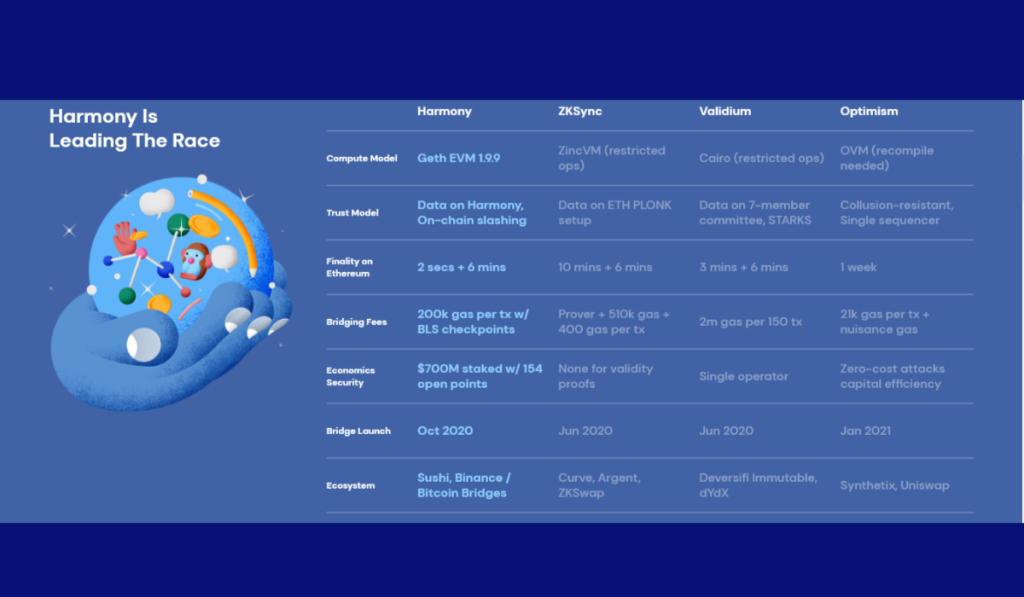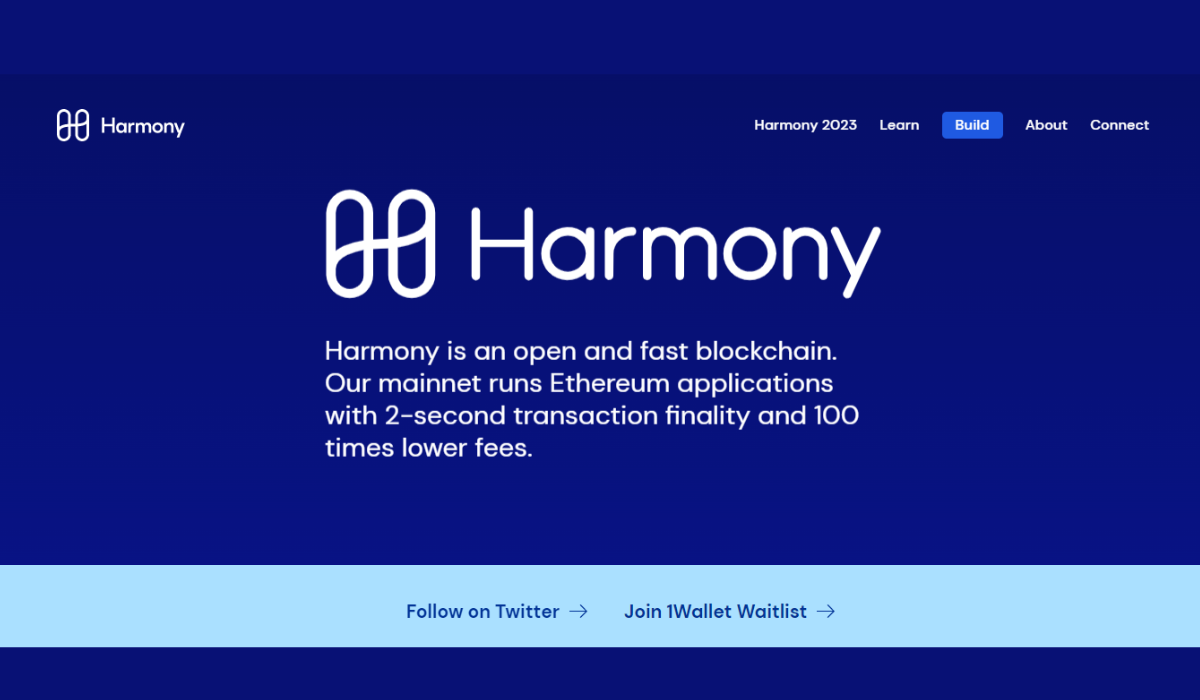A Complete Guide to Harmony ONE Cryptocurrency
Cryptocurrency is a digital or virtual currency that uses cryptography for security. It operates independently of a central bank or government, allowing for decentralized and borderless transactions. One of the most popular forms of cryptocurrency is Bitcoin, which was created in 2009 and has since seen a tremendous rise in value and popularity.
Harmony ONE is a newer cryptocurrency that aims to build a high-performance, decentralized, and secure blockchain. It differs from other cryptocurrencies because it utilizes deep sharding, a scalability solution that allows faster and more efficient transaction processing.
It uses a consensus algorithm called FBFT (Fast Byzantine Fault Tolerance) that enables quick and efficient consensus and cross-shard communication for interoperability between shards.
What Is Harmony ONE Trying to Achieve?
Harmony aims to build a high-performance, decentralized, and secure blockchain that can handle thousands of transactions per second. Blockchain technology has the potential to revolutionize many industries.

However, it faces several challenges, such as scalability, security, and interoperability. These challenges are particularly significant for public blockchains that are open to everyone and need to handle many transactions.
Harmony aims to overcome these challenges by using deep sharding, a scalability solution that allows the blockchain to process transactions more efficiently. By dividing the shard chain into smaller pieces or shards, the network can process transactions in parallel rather than sequentially.
This allows for a significant increase in transaction processing capacity. Harmony uses advanced security mechanisms to protect the shard chains from malicious actors and ensures network integrity through random sampling and staking.
How Does Harmony One’s Deep Sharding Work?
Harmony’s deep sharding system is based on dividing the shard chain into smaller pieces or shards. Each shard processes a subset of transactions, allowing the network to process transactions in parallel rather than sequentially.
This allows for a significant increase in transaction processing capacity. The shard chain is divided and organized using “deep sharding,” which involves further subdividing the shards into smaller sub-shards. This allows for even more parallelism and scalability benefits.
The scalability benefits of deep sharding are significant, as the network can handle a much larger number of transactions per second. The deep sharding system allows for fast confirmation times and low fees, making it more suitable for small-value transactions.
How Does Harmony’s Sharding Protect Itself?
Harmony’s deep sharding system is designed to be secure against malicious actors. Harmony uses several security mechanisms to protect the shard chains, such as random sampling and staking.
Random sampling is used to select validators to participate in the consensus process. These validators are chosen randomly from a pool of eligible stakes, and their selection is determined by the proportion of their stake in the network. This helps ensure a fair and decentralized consensus process.
Staking is another mechanism that is used to ensure network integrity. In staking, users lock up their tokens as collateral, and in return, they are given the right to validate transactions and earn rewards. This incentivizes users to act honestly and maintain the integrity of the network.
What Is the FBFT Consensus?
FBFT (Fast Byzantine Fault Tolerance) is a consensus algorithm that Harmony uses to reach consensus quickly and efficiently. FBFT is a proof-of-stake consensus mechanism that relies on validators to reach an agreement. These validators are chosen from a pool of eligible stakes, and their selection is determined by the proportion of their stake in the network.
In the FBFT consensus, validators work together to agree on the state of the network, including the order of transactions. This is done through a series of rounds, where validators communicate and propose blocks for inclusion in the chain.
Once a block is offered, other validators can vote on whether to include it in the chain. Once a supermajority of validators agrees on a block, it is added to the chain, and the process repeats. One of the critical advantages of FBFT is its ability to reach consensus quickly and efficiently, even in the presence of Byzantine (faulty or malicious) actors.
This is achieved through a combination of random sampling, staking, and other mechanisms designed to ensure the integrity of the network. Validators are incentivized to act honestly through the potential to earn rewards for their efforts.
Cross-shard Communication
One of the key challenges facing blockchain technology is interoperability between different networks. Harmony uses cross-shard communication to overcome this challenge of exchanging information and value across other shards.
Cross-shard communication is a mechanism that enables communication between different shards, allowing for the transfer of data and value between them. This is achieved through a process called cross-shard transactions, where a transaction initiated on one fragment can affect the state of another fragment. This allows for interoperability between shards, enabling the transfer of value and data across different fragments.
The Role of ONE Token
The ONE token is the native token of the Harmony network and plays several critical roles within the ecosystem. One of the keys used for ONE is for staking, where users can lock up their tokens as collateral to participate in the validation and consensus process and earn rewards for their efforts.
ONE can be used for governance, allowing holders to vote on network proposals and updates. It can also be used to access dapps, pay transaction fees, and access their services within the Harmony ecosystem.
Holding ONE also has potential benefits, such as earning staking rewards and participating in governance. With staking, users can earn interest on their ONE holdings, and with the government, they can have a say on how the network is run and how funds are allocated.
Use Cases for Harmony ONE
Harmony (ONE) has several potential use cases, including payments, remittances, and decentralized applications. Its high performance and low-cost characteristics make it suitable for small-value transactions and micropayments.
The cross-shard communication feature enables interoperability and the easy exchange of value across different shards, making it a suitable solution for remittances.
Decentralized applications (dapps) are also a potential use case for Harmony (ONE). Dapps can be built on the Harmony network, which can take advantage of the fast confirmation times and low fees provided by deep sharding.
Additionally, the interoperability provided by cross-shared communication allows for seamless interaction between different dapps and services, opening up innovation opportunities.
The Team and Roadmap
Harmony (ONE) is being developed by a team of experienced professionals from various backgrounds, including blockchain, cryptography, and distributed systems. The team is led by CEO Stephen Tse, who was previously Principal Engineer at Google. The rest of the group includes blockchain, cryptography, distributed systems, and software engineering experts.
Harmony (ONE) development and future developments are guided by a detailed roadmap, which lays out the project’s goals and milestones. The project has recently released its mainnet, which is the first step towards achieving its goal of building a high-performance and secure blockchain. The project is also working on further developing its deep sharding system and implementing new features such as interoperability and governance.
Shortly, the project plans to focus on its ecosystem’s growth and its technology’s adoption. This includes the development of more dapps, the expansion of its partnerships, and the continued development of its cross-shard communication feature. The team plans to focus on increasing the network’s decentralization by encouraging more people to participate in staking and governance.
How to Buy and Store Harmony (ONE)
Harmony (ONE) can be bought and sold on cryptocurrency exchanges, including Binance, Huobi, and OKEx. It can also be believed and sold over the counter (OTC) through different OTC platforms.
When buying Harmony (ONE), it is essential to thoroughly research the exchange or platform you plan to use and to keep your personal information and assets secure.
To store Harmony (ONE) safely, it is recommended to use a wallet that supports it, such as Ledger or Trezor. These wallets provide a way to store your tokens offline, away from the internet, which makes it much harder for hackers to access your funds.
Conclusion
Harmony (ONE) is a newer cryptocurrency aiming to build a high-performance, decentralized, and secure blockchain using deep sharding and the FBFT consensus algorithm. It seeks to overcome blockchain technology’s main challenges, such as scalability, security, and interoperability.
With deep sharding and the cross-shard communication feature, Harmony has the potential to handle thousands of transactions per second and allows for interoperability between different shards.
The ONE token plays a vital role in the ecosystem, with the ability to use for staking, governance, accessing dapps, and more. With a solid and experienced team, a clear roadmap, and an expanding ecosystem, Harmony (ONE) have the potential to become a significant player in the crypto market.











